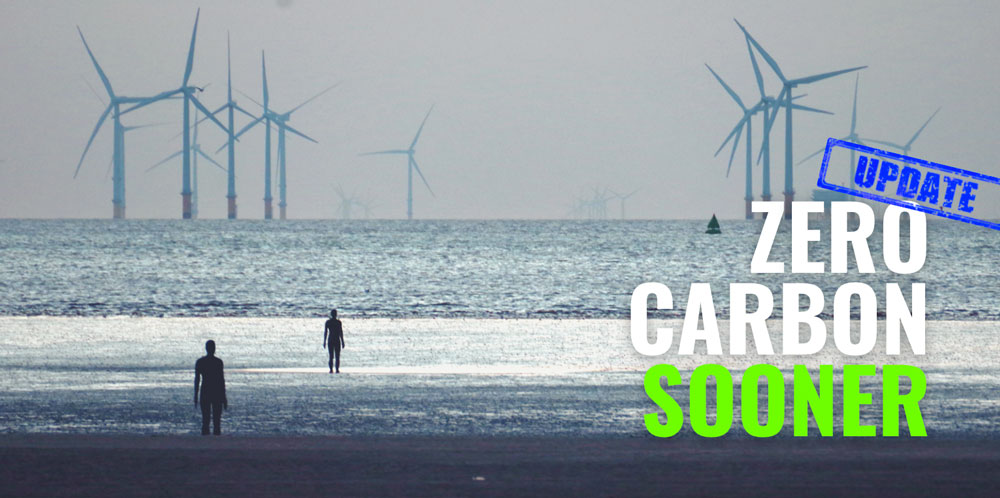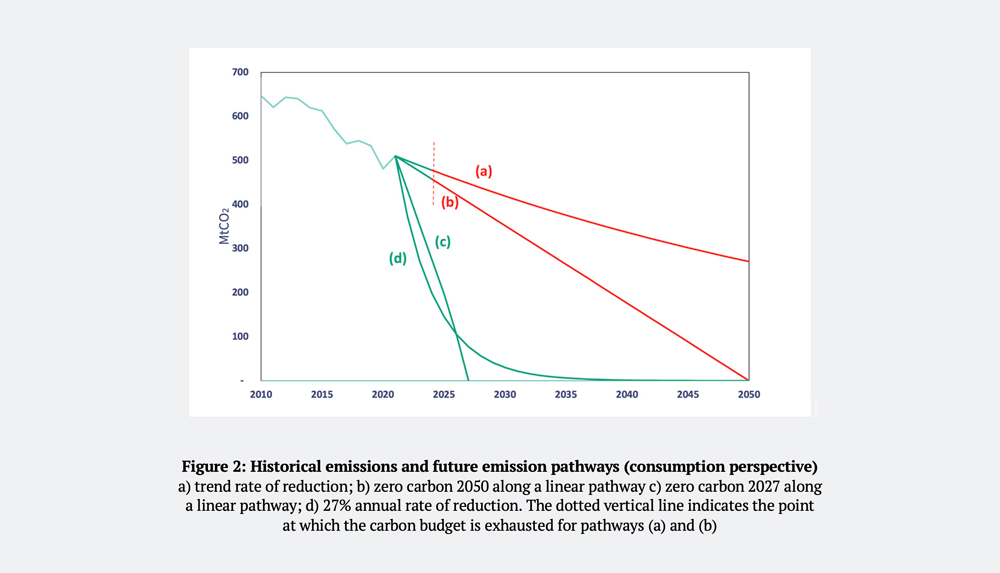Zero Carbon Sooner—Revised case for an early zero carbon target for the UK
Tim Jackson
CUSP Working Paper Series | No 29

Summary
This paper is an update of an earlier briefing note[1], revised to take account of new findings from the IPCC’s updated 6th Assessment Report (AR6). The broad aim of the paper is to establish how soon the UK should aim for (net) zero carbon emissions. The paper first derives a ‘fair remaining carbon budget’ for the UK. It then analyses a variety of emission pathways and target dates for their adequacy in terms of remaining within this budget.
A first key finding is that a target date for zero carbon is not sufficient in itself to determine whether the UK remains within its carbon budget. Policy must specify both a target date and an associated emissions pathway. A second key finding is that the sufficiency of these targets and pathways depends crucially on whether emissions are accounted for on a ‘territorial’ basis or on a ‘consumption’ basis.
For a linear reduction pathway not to exceed the remaining carbon budget the net zero target year would have to be between 2027 and 2032, depending on the accounting framework. For a target year of 2050, the average rate of emission reductions must lie in the range 17-27% if the UK’s fair budget is not to be exceeded. As measured on a consumption basis, these rates would require absolute reductions approaching 95% of current carbon emissions as early as 2030. Consequently, this paper argues in favour of setting a UK target for net zero carbon emissions no later than 2035, with a maximum of around 5% of the mitigation effort achieved through negative emission technologies.
Download
The full working paper is available for download in pdf (1.4MB). | Jackson T 2021. Zero Carbon Sooner—Revised case for an early zero carbon target for the UK. CUSP Working Paper No 29. Guildford: University of Surrey.
Introduction
In August this year, the Intergovernmental Panel on Climate Change (IPCC) published the first findings from its 6th Assessment Report. The findings reiterate the scientific consensus that a 1.5o C warming above pre-industrial levels carries significant risks for ecosystems and for human society. But they also confirm that 1.5o C is a much safer target than 2o C warming, at which point all of those risks would be substantially amplified.[2] On the advice of the Climate Change Commission, the UK has now set a national target to reach net zero carbon emissions by 2050 and recently announced plans to decarbonise the power sector by 2035.[3]
This paper argues that neither of these targets will be sufficient on their own to ensure that the government is acting in a manner consistent with a ‘fair remaining carbon budget’ for the UK. On the contrary, it suggests that the UK should aim for a zero carbon target considerably sooner than 2050, perhaps as soon as 2030-2035. It is worth noting that other countries have already adopted earlier target dates. Sweden has a net zero target for 2045, Finland for 2035 and Norway for 2030—the most ambitious of any government.[4] Some climate activists have called for the UK to eliminate all carbon emissions by 2025.[5]
The Remaining Carbon Budget
The starting point for consideration of a zero-carbon target is what the IPCC calls the ‘remaining carbon budget’. This is the amount of carbon dioxide (CO2) that can be emitted into the atmosphere from now until net zero is reached.[6] The IPCC’s 6th Assessment Report estimates that to have a 67% likelihood of staying below the 1.5o C warming target, the remaining global carbon budget from the beginning of 2020 until the point at which net zero is reached would be 400 GtCO2 (billion tonnes of CO2).[7] During the year 2020, despite a 7% fall in emissions from fossil fuels and industry associated with the Covid-19 pandemic, global carbon dioxide emissions amounted to 40 GtCO2 per annum.[8] If emissions were to stay at this level, the remaining budget would be exhausted by the beginning of 2030. It is already clear, however, that the decline in emissions witnessed through 2020 has not been sustained during 2021.[9] With rising emissions the global remaining carbon budget would be exhausted before 2030.
A Fair Carbon Budget for the UK
The question of an appropriate remaining carbon budget for the UK depends on both arithmetical assumptions and the ethical position taken in relation to the UK’s current level of emissions, its historical responsibility for greenhouse gas emissions and the rights of the poorest countries in the world to develop their economies and allow their citizens a decent quality of life.
If we were simply to divide the global remaining carbon budget and allocate it on an equal per capita basis, assuming that the global population stabilises at around 10 billion people in 2050 and the UK population stabilises at 70 million at around the same time, then the UK’s pro rata share of the remaining budget would be 2.8 Gt CO2.
There is however a very strong argument that a ‘fair remaining carbon budget’ would be significantly lower than this. On a territorial basis, as reported to the IPCC, UK per capita emissions are currently 16% higher than the global average per capita emissions. On a consumption basis, taking into account the emissions embedded in traded goods and those from international aviation and shipping, UK per capita emissions are 70% higher than the global average.[10] A relatively conservative position would be to reduce the remaining budget for the UK by a proportion equal to the current excess in per capita emissions. As measured on a territorial basis this would leave a fair remaining budget of just under 2.4 GtCO2. There may well be an argument for reducing this further.[11] But for the purposes of this paper, we assume a fair remaining carbon budget for the UK of 2.4 GtCO2.
How long can the UK ‘fair remaining budget’ last?
There is no simple answer to the question of how long this fair budget will last. It depends how fast we cut our carbon emissions over time. If we cut emissions faster, we can afford a later target. If we cut too slowly, the budget will be exhausted and we will be faced with the task of installing uncertain and costly ‘negative emission technologies’[12] to take carbon out of the atmosphere (and potentially the oceans) to try and stabilise the climate.
The time to exhaustion of the budget also depends on the basis on which we account for UK emissions—whether on a territorial basis, counting only the emissions generated on UK soil, or on a consumption basis, counting the emissions associated with UK consumption patterns including those from international aviation and shipping and those embedded in trade with the rest of the world. The position taken in this paper is that the consumption perspective is the correct one when viewed from an ethical perspective. But in either case, we can get some sense of how long the budget will last by making different assumptions about the rate of emissions reduction.
Territorial basis
On a territorial basis, carbon emissions in the UK declined at around 3.6% per annum in th decade to 2019. During 2020, an 11% decline was measured, mainly as a result of falling transport emissions during the coronavirus lockdown. Emissions in 2020, measured on a territorial basis, were 326 MtCO2 but they have subsequently rebounded, as the lockdown was eased, and emissions in 2021 are likely to rise above 330 MtCO2.[13] Assuming that the emission pathway returns to the trend rate of reduction beyond this year, the carbon budget is likely to be exhausted by 2027 (see Figure 1(a)). By 2050, emission levels would still be over 100 MtCO2 per year, leading to a ‘carbon overdraft’[14] of more than 4 GtCO2.

Suppose instead that we aim for a linear emissions reduction path designed to reach the current UK target for net zero of 2050. Though it meets the policy target, the UK would nevertheless exceed its fair remaining budget at more or less the same time as for the trend pathway (Figure 1(b)). By 2050 the carbon overdraft would be still be over 3 GtCO2. In fact, the latest year that we could afford to reach zero carbon emissions on a territorial basis along a linear pathway, without exceeding the carbon budget, would be 2032, in just over a decade’s time (Figure 1(c)).
It remains possible of course to try and extend the available budget by cutting emissions faster than the linear trend. Suppose, for example, that instead of following a linear path, we were to cut emissions by around 17% year on year over the next three decades. Under this assumption (Figure 1(d)), emissions in 2050 would be less than 2 MtCO2 per year, and the remaining budget would be around 0.5 MtCO2. At a reduction rate of 16%, however, only slightly lower than this, the budget would have been exhausted by 2040 and we would need to use ‘negative emissions technologies’ to remain at net zero until the end of the century.
Consumption footprint basis
Territorial emissions underestimate the carbon footprint of UK citizens by omitting some of the carbon associated with UK consumption patterns. The territorial (production) account omits international aviation and shipping emissions. It also leaves out the carbon embedded in imported goods and services. There are strong moral arguments to suggest that the UK should adopt a target which reduces its carbon footprint to zero (or net zero) rather than simply its territorial (production-based) emissions.[15]
Measured on this ‘consumption’ basis, emissions in 2018 were 545 MtCO2—more than 40% higher than production-based emissions.[16] Consumption based emissions have also been falling over the last decade, although at an average rate of only 1.9% per year, considerably more slowly than the decline in production-based emissions. Extrapolating this trend suggests a carbon footprint of around 535 MtCO2 in 2019 and something in the region of 480 MtCO2 in 2020 when the footprint will have been suppressed by the decline in economic output during the pandemic lockdown. As the economy recovers there is likely to be an upward pressure on consumption-based emissions in 2021. Assuming that the footprint returns eventually to its pre-2020 trend, the UK’s fair carbon budget is likely to be exhausted by 2025, in just over three years’ time, at which point emissions would still be in excess of 470 MtCO2 (Figure 2(a)). Without a massive deployment of costly and uncertain negative emissions technologies, the ‘carbon overdraft’ in 2050 would be almost 10 GtCO2.
A linear pathway leading to zero emissions on a consumption basis by 2050 would still leave the UK overdrawn on its carbon budget at about the same time as for the trend pathway (Figure 2(b)). Though this pathway clearly meets the UK’s current net zero policy target, it fails completely to remain within the fair budget. In fact, the carbon overdraft by 2050 would still be almost 6 GtCO2.
It turns out that the latest date at which we could aim for zero carbon along a linear pathway without exceeding the carbon budget would be the beginning of 2027 (Figure 2(c)). To achieve that target, the annual average reduction would need to be almost 80 MtCO2 per year over the next six years—half as much again as the estimated decline in emissions during the 2020 lockdown.
Once again, it is possible to conceive of emissions pathways that lengthen the time to exhaustion of the carbon budget by exceeding the linear reduction rate in the early years. For example, a year-on-year reduction of around 27% (see Figure 2 (d)) would extend the UK’s budget until 2050. At a slightly slower reduction rate of 26%, however, the budget would be exhausted by the early 2030s.

It is interesting to note that for emission pathways with such a fast rate of decline the residual emissions in the early 2030s are less than 30 MtCO2, almost 95% lower than consumption-based emissions today. This level of emissions may well lie within the range of feasible options for negative emissions technologies in the UK.[17]
What does this mean in terms of zero carbon targets?
The implications of this analysis for the UK are profound. The first and most important lesson is that neither the current UK target for net zero, nor complete decarbonisation of the power sector by 2035 are, on their own, sufficient to guarantee that the country remains within its fair carbon budget. In fact, when measuring carbon emissions on a consumption basis, a net zero target of 2050 could lead to a ‘carbon overdraft’ more than twice the size of the UK’s ‘fair carbon budget’.
Remaining within any budget depends inherently on the emissions pathway the country follows. Policy must align any target date for zero carbon with a proposed emissions reduction pathway. The current interim targets of 68% reduction by 2030 and 78% reduction by 2035 over 1990 levels do not achieve this.[18] It is essential to put in place a policy process to re-align the target date frequently if the actual emission pathway deviates from the target emissions pathway, since this will inevitably shift the timescale on which the budget is exhausted.
It is also worth pointing out that each year that the target level of emissions reduction is not achieved, the task in subsequent years gets significantly harder. Missing even one year of the required reductions along the pathway would change all the calculations, leading to higher reduction requirements in subsequent years and making it substantially more difficult to stay within the carbon budget.
When it comes to identifying an appropriate target for the UK, this briefing paper has been led by several principles:
- that the UK should remain within a fair carbon budget, calculated pro rata on a per capita basis and allowing a margin for to account for its higher per capita emissions;
- that emissions should be measured on a consumption basis to include all those emissions for which UK citizens are responsible;
- that reliance on negative emission technologies should be used at a minimum level, consistent with evidence on their local availability and effectiveness.
Under these assumptions, the analysis here suggests that along a linear emissions reduction pathway, a target year consistent with a fair carbon budget could not be later than 2027. To achieve this target along a linear pathway, the UK would have to start cutting its carbon footprint by around 80 MtCO2 per year immediately.
It is possible for the target date to be extended beyond 2027 if only if the rate of reduction of carbon emissions is faster than the linear pathway in the early years. In fact, the target date for zero carbon could even be extended to 2050, if the annual rate of carbon emissions reduction were in the region of 27% every year between now and then. This would be equivalent to a reduction of 140 MtCO2 in the first year.
What is notable about such pathways is that within little more than a decade, carbon emissions must already have fallen to a very low level. For example, with a 27% rate of reduction, the UK carbon footprint would already have fallen to only 21 MtCO2 by 2031 ((Figure 2(d)). This is less than 5% of the current level of emissions, measured on a consumption basis. Such a level of emissions could conceivably be offset by a careful programme of domestic negative emissions technologies, without imposing high and uncertain costs on future generations or on other countries.
There is nothing that can substitute for early ‘deep’ carbon reductions when it comes to making the task easier in the long run. In these circumstances, it makes no sense to set a target date of 2050 and can even be damaging if it is seen as too far beyond current political or electoral cycles. The most appropriate way to ensure that the UK remains within its fair carbon budget is to aim for an early net zero target somewhere between 2030 and 2035 with a defined maximum level of negative emission technologies. A later target could only be set if the early rate of reduction is sufficient to ensure that the fair carbon budget is not exceeded, without excessive use of negative emission technologies.
It is clear that the reductions involved here are very substantial. The level implied by the linear pathway exceeds the estimated decline in consumption-based emissions during the pandemic lockdown by 50% and has only been approached once since 1990, in the year 2009, when the carbon footprint fell by 75 MtCO2 during the financial crisis. But there has been no sustained period of year-on-year decline in the carbon footprint at anything like that level outside those extreme circumstances.[19]
Adopting a consumption-based approach poses an additional challenge in terms of the degree of control over the emissions embedded in UK trade. There do exist policy measures—carbon border tariffs for example—which could influence these emissions, but control is clearly less immediate than in the case of domestic emissions. The territorial emissions accounting approach adopted in current IPCC reporting eliminates this pressure and reduces the challenging nature of the reductions needed. But it does not appropriately take account of the UK’s carbon responsibilities.
Ultimately, the setting of a target date depends on the position a country takes in relation to its global responsibility and the speed with which it is prepared to take action to reduce emissions to net zero. Despite the challenges associated with such extensive emission reductions, the lessons from this analysis are clear. There is every indication that the current UK net zero target of 2050 is insufficient either to reflect our global responsibility or to motivate the early action that is needed if the carbon budget is not to be exhausted long before the target date.
In summary, the moral and prudential case for the UK to adopt a zero target sooner than 2050—perhaps as soon as 2030—appears to be a very strong one.
Notes
[1] Jackson T 2019: Zero Carbon Sooner. CUSP Working Paper No 18. Guildford: University of Surrey.
[2] IPCC 2021 WG 1 Contribution to the 6th Assessment Report: Summary for Policymakers. Online at: https://www.ipcc.ch/report/ar6/wg1/downloads/report/IPCC_AR6_WGI_SPM.pdf. See also: IPCC 2018 SR15—Summary for policymakers. Online at: https://www.ipcc.ch/site/assets/uploads/sites/2/2019/05/SR15_SPM_version_report_LR.pdf
[3] HMG 2021. Plans unveiled to decarbonise UK power system by 2035. Online at: https://www.gov.uk/government/news/plans-unveiled-to-decarbonise-uk-power-system-by-2035. See also CCC 2019. Net zero—the UK’s contribution to stopping global warming. Online at: https://www.theccc.org.uk/publication/net-zero-the-uks-contribution-to-stopping-global-warming/.
[4] See: https://www.climatechangenews.com/2019/06/03/finland-carbon-neutral-2035-one-fastest-targets-ever-set/; http://www.climateaction.org/news/norway_brings_forward_carbon_neutral_target_to_2030.
[5] https://rebellion.earth/the-truth/demands/.
[6] In looking at carbon emissions and the rate of decarbonisation this note only explores CO2 emissions. This is consistent with the use of an overall budget denominated in terms of CO2. But as IPCC SR15 (see note 2) makes clear, the CO2 budget also depends on what happens to non-CO2 greenhouse gases. This would need to be explored separately.
[7] IPCC 2021 Table SPM 2, p38 (see note 2).
[8] Global Carbon Project 2020. Global Carbon Budget 2020. Online at: https://www.globalcarbonproject.org/carbonbudget/20/publications.htm. See also Carbon Brief 2020. Coronavirus causes record fall in carbon emissions during 2020. Online at: https://www.carbonbrief.org/global-carbon-project-coronavirus-causes-record-fall-in-fossil-fuel-emissions-in-2020.
[9] IEA 2021. Global carbon emissions are set for their second-biggest increase in history. Online at: https://www.iea.org/news/global-carbon-dioxide-emissions-are-set-for-their-second-biggest-increase-in-history.
[10] In 2019, global average per capita fossil fuel emissions were 4.7 tonnes per person. For the UK the figure was 5.5 tonnes when measured on a territorial basis and 8.1 tonnes when measured on a consumption basis. Data from the Our World in Data online database at: https://github.com/owid/co2-data.
[11] For instance, if the fair budget were calculated on the basis of the excess in consumption based emissions, it would be a little over 0.8 Gt CO2—barely a couple of years of emissions at current rates.
[12] See for example: https://www.carbonbrief.org/guest-post-seven-key-things-to-know-about-negative-emissions; https://royalsociety.org/~/media/policy/projects/greenhouse-gas-removal/royal-society-greenhouse-gas-removal-report-2018.pdf.
[13] BEIS 2021. 2020 UK greenhouse gas emissions, provisional statistics. March 2021. Online at: https://assets.publishing.service.gov.uk/government/uploads/system/uploads/attachment_data/file/972583/2020_Provisional_emissions_statistics_report.pdf.
[14] I use this term here to refer to an exceedance of the carbon budget. It is directly analogous to the concept of a bank overdraft, which arises when our spending exceeds the allowable funds—except that in the case of carbon the only ‘banker’ is future generations and the ‘overdraft’ is unauthorised.
[15] https://www.theguardian.com/environment/2019/jul/14/climate-crisis-carbon-emissions-leakage-labour-party-corbyn
[16] See Defra 2019. UK’s Carbon Footprint 1990—2018. Online at: https://assets.publishing.service.gov.uk/government/uploads/system/uploads/attachment_data/file/794557/Consumption_emissions_April19.pdf.
[17] The Royal Society and the Royal Academy of Engineering report (note 12) includes a scenario which achieves 35 MtCO2 from negative emissions technologies by 2050 for instance.
[18] CCC 2020. Sixth Carbon Budget. Climate Change Committee. Online at: https://www.theccc.org.uk/publication/sixth-carbon-budget/.
[19] See Defra 2019 (note 16).
Download
The full working paper is available for download in pdf (1.4MB). | Jackson T 2021. Zero Carbon Sooner—Revised case for an early zero carbon target for the UK. CUSP Working Paper No 29. Guildford: University of Surrey.



